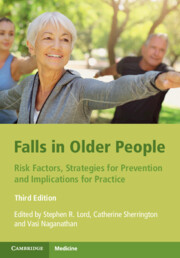Book contents
- Falls in Older People
- Falls in Older People
- Copyright page
- Contents
- Preface
- Contributors
- Part I Epidemiology and Risk Factors for Falls
- 1 Epidemiology of Falls and Fall-Related Injuries
- 2 Postural Stability and Falls
- 3 Gait Characteristics and Falls
- 4 Sensory and Neuromuscular Risk Factors for Falls
- 5 Biomechanics of Balance and Falling
- 6 Foot Problems, Footwear, and Falls
- 7 Brain Function and Falls
- 8 Impaired Cognition and Falls
- 9 The Psychology of Fall Risk: Fear, Anxiety, Depression, and Balance Confidence
- 10 Medical Risk Factors for Falls
- 11 Medications as Risk Factors for Falls
- 12 Environmental Risk Factors for Falls
- 13 Fall Detection and Risk Assessment with New Technologies
- 14 Fall Risk Screening and Assessment
- 15 The Relative Importance of Fall Risk Factors: Analysis and Summary
- Part II Strategies for Prevention
- Part III Implications for Practice
- Index
- References
12 - Environmental Risk Factors for Falls
from Part I - Epidemiology and Risk Factors for Falls
Published online by Cambridge University Press: 04 November 2021
- Falls in Older People
- Falls in Older People
- Copyright page
- Contents
- Preface
- Contributors
- Part I Epidemiology and Risk Factors for Falls
- 1 Epidemiology of Falls and Fall-Related Injuries
- 2 Postural Stability and Falls
- 3 Gait Characteristics and Falls
- 4 Sensory and Neuromuscular Risk Factors for Falls
- 5 Biomechanics of Balance and Falling
- 6 Foot Problems, Footwear, and Falls
- 7 Brain Function and Falls
- 8 Impaired Cognition and Falls
- 9 The Psychology of Fall Risk: Fear, Anxiety, Depression, and Balance Confidence
- 10 Medical Risk Factors for Falls
- 11 Medications as Risk Factors for Falls
- 12 Environmental Risk Factors for Falls
- 13 Fall Detection and Risk Assessment with New Technologies
- 14 Fall Risk Screening and Assessment
- 15 The Relative Importance of Fall Risk Factors: Analysis and Summary
- Part II Strategies for Prevention
- Part III Implications for Practice
- Index
- References
Summary
In relation to falls in older people, the focus on the environment is often restricted to the individual’s immediate home surroundings [1]. However, the environment can be conceptualized on three levels: the individual’s immediate home surroundings, which is the home and adjoining grounds, the wider community or local neighbourhood, and the country, including the social, cultural, and political context of the society in which the person lives, including accessibility, potential hazards relating to public facilities, government policy on environmental design, housing standards, public transport, neighbourhood conditions, and social networks [2]. Within each of these levels, the environment comprises social and physical elements [3]. In this chapter, the environment in relation to falls is defined as ‘the context within which the occupational performance of the person takes place. It influences behaviour and in turn is influenced by the behaviour of the person’ [4, p17]. This inclusive definition is used because there have been promising study findings suggesting that fall prevention interventions are effective in the wider community [5–8]. Further, there is debate about whether research should separately address falls in the home environment and those in the wider community, because hazards and risk factor profiles of people who fall in these environments differ [9–11].
- Type
- Chapter
- Information
- Falls in Older PeopleRisk Factors, Strategies for Prevention and Implications for Practice, pp. 202 - 210Publisher: Cambridge University PressPrint publication year: 2021
References
- 2
- Cited by



